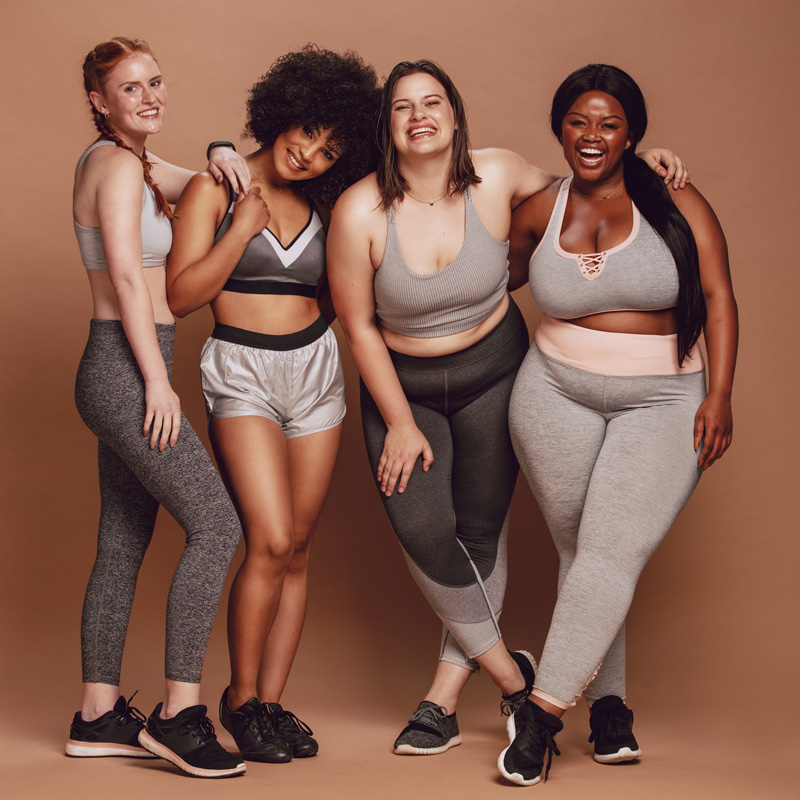Movement – Feel the difference
This is the ninth post in a 10-part series looking at the principles of Intuitive Eating. The previous post in this series was on Respect Your Body.
Just as the earlier principles of Intuitive Eating helps you put some of the joy back into eating, the ninth principle – Movement – Feel the Difference – helps you put some of the joy back into moving your body.
What does your relationship with exercise look like?
Before exploring this pinciple, I invite you to first reflect on what your relationship with exercise has looked like in the past and how it looks like now. Many people have a difficult relationship with exercise because they associate it with dieting and trying to lose weight. That’s understandable, given that we’ve been socialised by diet culture to connect exercise with dieting and trying to lose weight. And it’s also the reason why this Intuitive Eating principle is called Movement – Feel the Difference*.
Some questions that might help you start reflecting on your relationship with exercise include: How do you feel about exercise? Do you enjoy it or hate it? Is it just another thing to do on your long to-do-list? Have you struggled or are you currently struggling with over-exercising? Is it even a priority for you? What have your past experiences with exercise looked like?
I think it’s important to acknowledge that movement isn’t a priority for everyone. And if that’s the case for you, it doesn’t change the fact that you and your body still deserve to be treated respectfully. Just like the way you choose to nourish yourself, whether you exercise or not, has nothing to do with your moral worth or value as a person.
Also, if you’ve had a difficult relationship with movement (for example, because you’ve been struggling with over-exercising or with restrictive eating behaviours), taking a break from moving your body may be more what you need. And if you’ve just started learning about Intuitive Eating, you will benefit from from working first through some or even all of the earlier principles of Intuitive Eating (1-8). Give yourself “permission” to come back to this principle when you feel ready. Feeling ready to move again might look like realising you actually want to move your body as opposed to feeling like you “should” or you “must”. Keep in mind that postponing moving your body for a few weeks or even a few months will not affect your long-term health and doing so can be especially important if you’ve tended to over-exercise in the past.
If however, you feel ready to explore joyful movement, please read on!
*I have tried to use the words “move” and “movement” as often as possible in this blog. On occasion, I have used the word “exercise” when it seemed important for contextual reasons.
What are your barriers to joyful movement?
A good place to start is to reflect on whether there are any barriers to joyful movement in your life. To figure this out , begin by asking yourself what your reasons are for moving or not moving your body.
If you do move your body, is it because you want to want to “burn calories” or because it feels good, energises you, helps you clear your head, or helps manage any chronic stress you feel? If one of the reasons you move your body is because you want to “burn calories”, it will be important to uncouple exercise from weight loss (I explain why in more detail below).
And if you aren’t moving your body but would like to, can you get curious about why that is, in a compassionate and non-judgemental way? Maybe you began exercising at the same time as starting a diet and your energy intake from food was too low for you to find it invigorating, let alone fun. Perhaps you had a bad experience as a child? Maybe you were pushed to exercise as a way to control your weight by a parent, or a sports coach which led to you rebelling against it?
Other reasons why you might not feel like moving your body or have stopped doing so can be:
- Feeling intimidated in the gym because of weight stigma and the absence of other people in bigger bodies. This is a valid concern. Unfortunately, there are still very few places where people in bigger bodies can exercise without being judged or shamed.
- Not having suitable or comfortable clothing for your preferred form of movement. Again, I think it’s important to note the range of sport clothing for people in bigger bodies is extremely limited.
- Being teased for being uncoordinated or clumsy as a child.
- Having unrealistic exercise goals.
Breaking through exercise barriers
Once you’ve had time to consider any barriers to joyful exercise in your life, can you think about how you might remove those barriers? Here are some you might like to start reflecting on.
1. Decouple exercise from weight loss
Diet culture would have us believe that exercise leads to long term weight loss, but the truth is that exercise does not guarantee significant long term weight loss for most people. Just like dieting, exercising intensely for a period of time may lead to some weight loss, but it is mostly temporary and hard to sustain in the long-term. Not surprisingly, this can lead to feeling frustrated and giving up when you aren’t seeing the results you want — especially if you are moving in a way you don’t really enjoy.
That being said, there are lots of other benefits of exercise that make it worth doing, such as improved mood, focus, energy and body image, improved metabolic and cardio-respiratory health, increased bone strength and lean muscle tissue. And, importantly, research (CW) tells us we can reap these benefits regardless of body weight or size or whether weight loss occurs or not.
In other words, when you make weight loss your main motivation for moving, you will most likely be disappointed, stop exercising and miss out on all the great mental and physical health benefits of moving your body. You might also end up overexercising – which can lead to injury. This is why decoupling exercise from weight loss is so important.
2. Focus on how it feels
Instead of focussing on the number of calories “burned” or steps taken, focus instead on how moving your body feels. Paying attention to how your body feels when you move it a certain way is a form of interceptive awareness (being aware of the cues your body is sending you, like feeling cold, needing to go to the bathroom, hunger, fullness etc.) – an important concept in Intuitive Eating.
When I was a child, I never enjoyed school sports lessons that involved any kind of running. Running just didn’t feel good in my body and I often felt physically sick when I tried to keep up with some of my school friends who were better runners than me. In contrast, my body always felt good and at home in the water so I always enjoyed swimming (and still do). I’m not suggesting you shouldn’t run or jog or that you should swim. My point is, the way we experience movement, and the extent to which we enjoy different types of movement, is very individual. Also, moving your body in a way that doesn’t feel good is never going to be something you will want to do long term. And moving your body in a way that feels good to you is something you will likely want to do long term. This is why it’s helpful to check in with how you feel when you move your body.
If you feel ready to start moving again, check in with how you feel before, during and after you move. Here are some key questions to consider:
- How is your energy level? How tired do you feel? Do you feel energised, more awake, more alert?
- What happens to your stress level? Do you feel better able to handle stress?
- Do you sleep better and wake up feeling more refreshed?
- What about your overall sense of well-being?
Even if you aren’t really active at the moment, it can be really helpful to note down how energised or stressed you feel currently or how well you are sleeping. These things can serve as your baseline and allow you to compare the difference in the way you feel if and when you begin moving your body again.
3. Focus on movement as a way of taking care of yourself
Focussing on movement as a way of taking care of yourself and respecting your body, can also help break down barriers to movement. Regularly moving our bodies is great for physical health, including lowering blood pressure, building heart and lung strength, and helping us build and maintain strong muscles and bones. It can also be helpful for improving sleep, managing any chronic stress we might have and for our mental health (if we don’t see it as yet another thing on our to-do-list).
4. Don’t get caught up in diet culture traps
If you’ve been dieting for some time, you might have gotten caught up in one of these diet culture mind traps and it can be important to work through refuting them:
The “it doesn’t count” mind trap
A lot of people get caught up thinking that unless they exercise for a certain length of time (e.g. walk for an hour) that it doesn’t count. And instead do nothing. Or they discount what they were able to achieve because they “only” moved three times in the week, rather than five. Remember, everything you do counts.
The “no-time-to spare” mind trap
Most people, when asked will agree that exercise is important. Yet, when we have so many other things in our lives competing for our time and energy, it so often gets pushed aside. When you’re busy, and you have many things on your plate, it can feel challenging to fit exercise into your schedule — unless it’s joyful. If moving feels good, we’re more likely to prioritise it in our schedule. Making movement a priority in our life is not about allowing it to interfere with life, but rather about finding a realistic way that allows you to have regular, enjoyable movement in your life. Sometimes, you may need to (compassionately) evaluate your priorities, especially if you tend to be chronically overscheduled. It’s about finding a balance between for example, turning down social invitations because they conflict with your workout time and letting other things like housework, get in the way of joyful movement.
The “if I don’t sweat, it doesn’t count” mind trap
I’m going to nip this one in the bud and tell you that you do not have to rigorously work out to the point you are sweating profusely. You can and will reap health benefits from moving in ways that don’t necessarily cause you to sweat like gardening, walking, playing with your kids in the garden etc.
How to put the joy back into movement
Part of the reason for focussing on making moving fun is that when it feels good, it’s easier to sustain long-term. Consider:
Choose something you enjoy
You might like to think about whether you prefer exercising alone or with friends or family members. Or the ways you enjoyed moving as a child. Maybe you enjoyed swimming and took to the water like a fish. Perhaps you loved tennis, and would happily hit a ball around the court. Maybe you loved being in nature and going for walks in the park or forest, perhaps you enjoyed riding your bike or maybe you had fun skiing in the winter. If you already move your body regularly, does it still bring you joy? If not, what would it take to put some joy back into moving? Remember, all bodies are different, and each of us enjoy different activities. Find a way to move that is fun and works best for you and your unique body!
Vary the way you move.
Having a couple of different ways you like moving can help increase the enjoyment factor.
Ditch any apps or trackers
Ditching the apps or trackers that divert your attention away from your body and enjoying moving your body towards becoming fixated on calories or the number of steps taken. Having goals and targets and constantly feeling like you have to do better can suck the joy right out of moving.
Dress comfortably
If you aren’t dressed in a way that lets you move comfortably allows your body breathe, and is appropriate for the weather, moving will be less fun. Do you have sneakers that fit properly and are comfortable? A bra that supports you well? Clothing that protects you from the elements?
Rest when you need to
Sometimes, taking care of yourself, for example when you are tired, sick or injured, means choosing not to exercise. Listening to your body and resting is not only an important part of self-care, it also helps to keep moving fresh and fun.
Don’t forget incidental movement counts too!
Movement isn’t just about planned exercise. Yes, planned exercise you enjoy is great. And, all the incidental ways we move in daily life count too. This includes walking to the local shops, housework, gardening, playing with your kids (or grandkids), riding your bike to work (if you’re lucky enough to live close enough to do so) and more. Sometimes this kind of daily movement isn’t necessarily joyful, but it can improve your overall sense of well-being.
Short and sweet
Just as ditching rigid food rules helps you put some of the joy back into eating, ditching rigid rules about exercise is key to putting the joy back into moving your body and reaping the health benefits that come with movement. Moving your body doesn’t need to (and shouldn’t) interfere with your life and it should never be a means to punish yourself for what you eat.
Ready to take the next step? Contact me and request a complimentary call to find out more about Intuitive Eating and how it can help you truly nourish yourself – body, mind and soul.






